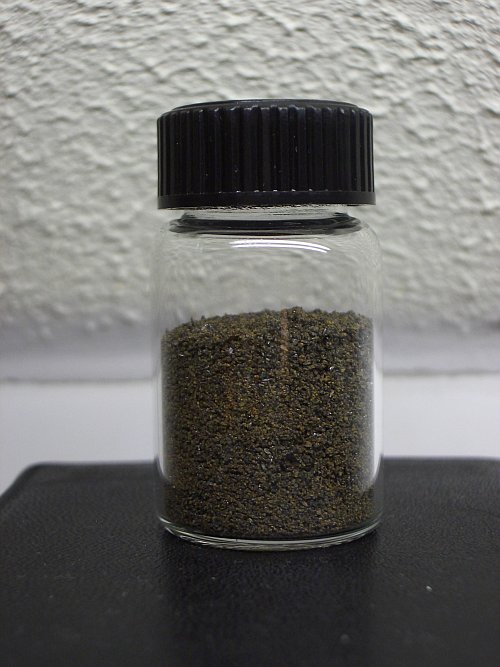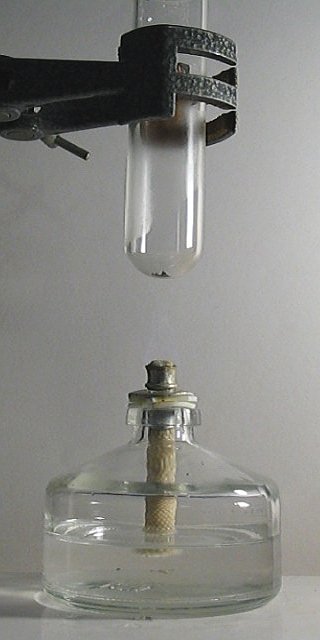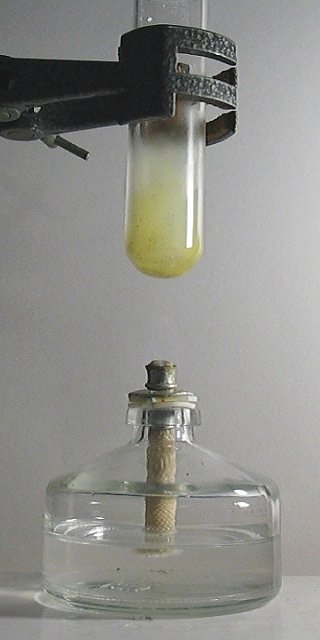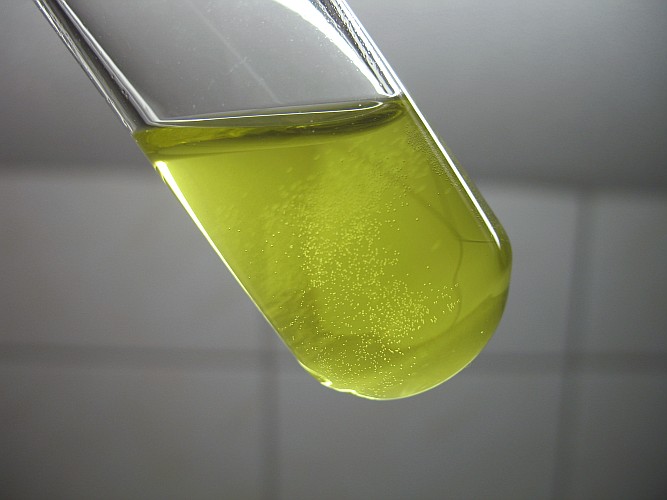


Explosive properties of peroxo chromate
More than 15 years ago, a small quantity of the compound potassium tetraperoxochromate (V) was made from KOH, K2Cr2O7 and H2O2. Making this chemical is fairly easy. The formula of this compound is K3CrO8, but it is better to write K3Cr(O2)4, because it contains 4 peroxo groups. This compound is quite remarkable, because it contains chromium in the +5 oxidation state, which is not common at all for chromium.
![]()
Synthesis of the peroxo compound
The recipe below certainly gives some solid K3CrO8:
- Take approximately 10 grams of solid K2Cr2O7
- Take approximately 20 grams of solid KOH. Dissolve this in 50 ml of water.
- Add the K2Cr2O7 to the solution of KOH. This should result in a deep bright yellow solution (all is converted to K2CrO4).
- Let the solution cool down in a refrigerator, such that it is freezing cold, but no ice may appear. If any crystals of K2CrO4 appear, then add a little more water.
- At the same time, cool down 30 ml of 30% H2O2. This solution also must be freezing cold, but again, without ice.
- Next, slowly drip the concentrated hydrogen peroxide in the ice cold yellow solution. This must be done with constant stirring, using a glass or a plastic rod, don't use metal tools. Never allow the temperature to rise above 0 şC. It is best to keep the beaker with the reaction mix in an ice cold bath of salt and ice, or in an ice cold salted water bath, which also was put in the refrigerator.
- If the temperature of the solution goes above 0 şC, then stop adding hydrogen peroxide and put it in the refrigerator again, together with the hydrogen peroxide. When all is ice cold again, then continue adding the remaining part of the hydrogen peroxide. Never allow the solution to heat up. Once a certain critical temperature is reached, it will runaway and all your work is spoiled in a lot of frothing and bubbling.
- While the hydrogen peroxide is added, the color of the solution turns from yellow to brown. After all hydrogen peroxide is added, put the solution in the refrigerator for a while, and brown crystals of K3CrO8 will settle at the bottom. It is hard to tell how long the solution must be in the refrigerator, but one hour should be sufficiently long.
- Decant the solution from the crystal mass. Put the wet crystal mass on a paper tissue. This will suck most liquid from the crystals. Next, rinse the crystals with some 95% ethanol. This will remove most impurities (remains of KOH and H2O2). Repeat this another time.
- Again, put the crystal mass on a paper tissue, such that most liquid is sucked away and carefully rub the mass between two layer of tissue, such that the crystals are not crushed. Let them dry in a warm place (e.g. place them in a petri dish and put this somewhere above a heating radiator). Be sure, however, that the crystals do not become hot. As long as you can bear the heat of the heating place with your bare hand, then the crystals also can. Allow the crystals to dry for one day. After that, they are perfectly dry. They are not hygroscopic at all and store exceptionally well and seem to have unlimited shelf-life (mine are more than 15 years old).
- This is the result of my synthesis:

![]()
Explosive properties of K3CrO8
Although the potassium tetraperoxo chromate (V) seems to be very stable (it can be stored for a very long time without deterioration), it becomes dangerously explosive, when heated. I was surprised by this reaction. I expected it to decompose slowly, when heated, but it explodes at once.
This compound is quite remarkable in another sense as well. A lot of compounds are known to be explosive, but this is because they contain an oxidizing and reducing part in the same compound (e.g. organic nitrate esters, or ammonia based inorganic complexes with a strongly oxidizing anion). This peroxo compound is explosive, solely on the basis of its large oxygen contents.
The two pictures below show the situation just before the explosion, and the situation approximately 30 ms later.


Two videos were made of this reaction. In both experiments a small quantity (around 25 mg) is put in a test tube, and then the test tube is put above the flame of a alcohol burner. After a short period of time, the potassium tetraperoxochromate explodes, leaving yellow smoke of potassium chromate and potassium (per)oxide, and oxygen. The videos should be played with sound on.
These are the two videos: explosion1.avi and explosion2.avi. Both files have a size well below 1 MByte.
The yellow smoke quickly dissolves, when some water is added (wait until the test tube has cooled down, otherwise the glass may crack due to thermal shock). When it dissolves, also some bubbles of oxygen are produced:
